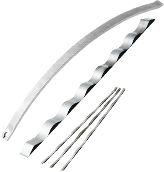- keyword
- springmaterials
- tempering
Question Morimoto 2008/8/13(Wed) 17:19
I have a question about tempering.
We manufacture elongated springs for looms, but the initial tension inevitably varies during coiling, and the variation is adjusted by the tempering temperature to match the product specifications. In this case, is there a difference in composition between the springs tempered at 250°C and the ones tempered at 350°C?
Example: Initial tension 60g → Processing at 250℃ → 50g; Initial tension 70g → Processing at 350℃ → 50g.
By the way, the material is SUS304 made by a domestic manufacturer, and the processing time is 15 minutes.
* SUS304(EQ to S30400 by ASTM, X5CrNi1810 by DIN, L-No6X5CrNi 18-9 by ISO )
Answer Tokai Spring 2008/8/20(Wed) 18:18
Thank you for writing to us, Morimoto! Basically, the composition (chemical composition) does not change due to the difference in tempering temperature and time.
Answer Morimoto 2008/8/28(Thu) 16:25
Thank you for your reply.
“Basically, the composition (chemical composition) does not change due to the difference in tempering temperature and time”. Does tempering here mean “annealing”? I understand that it is done to remove strain after processing, but SUS304 is austenitic stainless steel and is originally processed so that it does not stick to magnets. Isn’t it possible to return it to austenite by tempering it (it sticks to the magnet)? That means that the return condition changes depending on the temperature and time, and there may be a difference as a material. Is the difference caused by temperature and time only the change in color? Also, could you please tell me if you know the right temperature and time to temper?
Answer Tokai Spring 2008/8/29(Fri) 17:20
Hello! In the first place, your question was, “Is there a difference in composition?” The composition here can be understood as chemical components. Basically, the chemical composition does not change due to the difference in tempering temperature. Tempering does not change the material to austenite. In addition, it is estimated that the residual stress of the material will differ depending on the tempering temperature. In the case of a tension spring, the appropriate temperature and time should be lower when the set initial tension is large, and higher when the set initial tension is small.
* SUS304(EQ to S30400 by ASTM, X5CrNi1810 by DIN, L-No6X5CrNi 18-9 by ISO )
We are happy to answer any inquiries regarding technology, specifications, materials, etc. Please feel free to ask.

















